


|
THE FORTUNES OF A GREAT STATE The New Kingdom is one of the great periods of egyptian civilisation. Nubia participates in it, through its agricultural, mineral and human resources. During four centuries (c. 1550-1050 BC), Egypt could not have been a great empire if Nubia had not contributed to its splendour. Around 1600 BC, Egypt is divided into territories controlled by different families, north of Thebes, the Hyksos and the Nubians to the south. The XVII Dynasty (c. 1634-1543 BC) plays a major role in the renaissance of the country. It loosens the hold paralysing Thebes and occupies the ‘Corridor’ as far as Buhen, at the level of the Second Cataract. This strategy allows it to expand its southern frontier and impose a new relationship based on force. The most significant kings are Seqenenre Taa and Kamose. The latter erects stelae at Buhen where his name appears for the first time. He nominates to the position of viceroy a certain Teti, to whom he gives the title of ‘Kings Son’.
THE XVIII DYNASTY
The successor of Kamose, Ahmose I (c. 1543-1518 BC) begins the XVIII Dynasty. He liberates the towns of Memphis and Heliopolis. He pursues the Hyksos into their fief of Sharuhen to the south of Palestine, and looted the town. Ahmose then turned towards the south. He crossed the Second Cataract and the Batn el-Haggar and exterminated the Iuntyu Setyu, recalling the atrocities perpetrated against the A and C-Groups. Ahmose reached the island of Saï (inscribed blocks bearing the name of his spouse, the queen Ahmes Nefertari and a statue of the king were found there). It is possible that he ordered the construction of the fortress of Tombos, a strategic location above the Third Cataract situated some twenty kilometres from the capital of the kingdom of Kerma. |
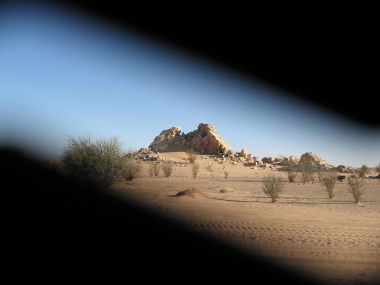 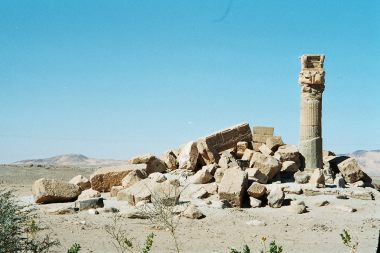 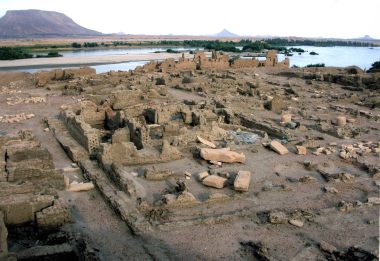 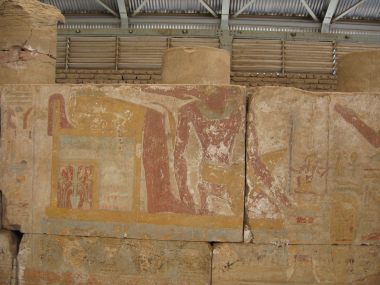 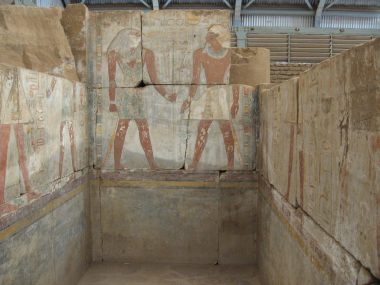 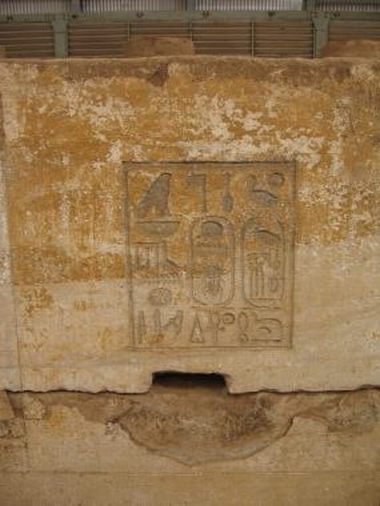 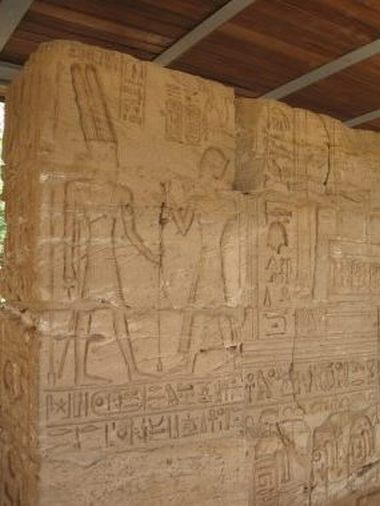 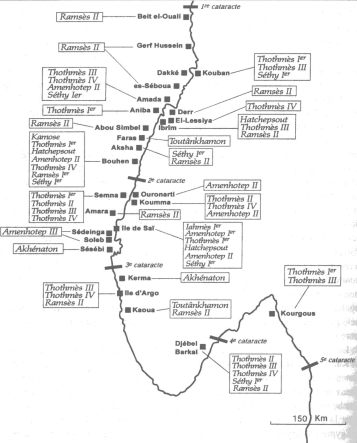 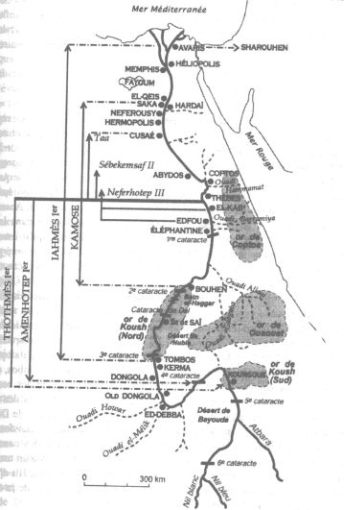 Quartz rock considered by Thotmès the First and Thotmès the Third as the limit of the egyptian territory / Rocher de quartz considéré comme une stèle frontière par Thotmès 1er et Thotmès III, marquant la limite fictive du territoire égyptien entre les Quatrième et Cinquième cataractes
Vestiges of Amenhotep III temple located at Soleb between the Third and Second Cataracts / Vestiges du temple jubilaire de Amenhotep III situé à Soleb entre les Troisième et Seconde Cataractes
Sedeinga temple in connection with the temple of Soleb where the queen Tyi is represented / Temple de Sedeinga associé au temple jubilaire de Soleb où la reine Tiy est présente
Egyptian settlement in Saï Island at the second millennium before Christ /Implantation égyptienne dans l'ile de Saï au deuxième millénaire avant notre ère
Temple of Bouhen where Thotmes III is offering the nou pots (Khartoum museum) / Temple de Bouhen avec l'offrande des pots nou par Thotmès III (musée de Khartoum)
Thotmès III is standing before the god Horus (Khartoum museum) / Thotmès III se présente devant le dieu Horus (musée de Khartoum)
Thotmes III crowning's name, Men Kheper Râ carved in an usual egg-shaped form (Khartoum museum) / Nom de couronnement de Thotmès III, Men Kheper Râ, inscrit dans un cartouche (musée de Khartoum)
Vestiges of Akcha temple built under the regn of Ramsès II (Khartoum museum) / Vestiges du temple d'Akcha construit sur ordre de Ramsès II (musée de Khartoum)
Temples built by the egyptian kings at the New Empire period along the nubian cataracts / Temples construits par les souverains égyptiens du Nouvel Empire au "pays des Cataractes"
Conquests of the egyptian kings at the beginning of the New Empire period / Conquêtes des souverains égyptiens au début du Nouvel Empire
|
|
His son, Amenhotep I (1517-1497 BC) succeeds him and probably advances as far as the Fourth Cataract. Did he make contacts with merchants from the heart of Africa? Like his father, at Saï he left inscribed blocks and a statue in his image. Tradition asserts that he created the office of ‘king’s son of Kush’, a title that under the New Kingdom applies to the control of a territory reaching as far south as the Fourth Cataract. Chosen from the entourage of the king, he is charged with the control of the regions of Upper and Lower Nubia. His administrative, military and religious functions give him power. One of his duties is the exploitation of the Nubian gold mines.
Ahmose I and Amenhotep I die young. Is this linked to the domination of Nubia? Since the morning of the death of Amenhotep I, his successor, Thutmose I (c. 1496-1483 BC) is designated as his successor. He is not of royal origin, no more than his wife, Ahmes. After his takeover, the event is announced in Lower Nubia: at Wadi Halfa, below the Second Cataract, at Kuban, where Wadi Allaqi joins the Nile, and at Aswan. This type of document was never promulgated for any other Egyptian sovereign. Two years later, Thutmose I leads a campaign towards the South. The Egyptian fleet is under the command of Ahmose, the son of Abana, and passes through the Fourth Cataract, and stops downriver from the Fifth Cataract. Thutmose I left an inscription at Kurgus on a quartz outcrop where he asserts Egyptian domination. This region is rich in gold mines, with Kush-south and Wawat-south. Returning to Tombos and Saï, he has further inscriptions engraved, confirming his victories in Nubia. After this raid, there is a new wave of activity in the fortresses of Semna and Buhen. Construction work is under way at Aniba, Kuban and at Qasr Ibrim.
See on the slide show, the map of the conquests of the New Empire first Egyptian Kings
Thutmose II appears to be the link between the spirit of conquest of the first kings and those that will apply a homogeneous policy on the Nile valley, from the delta to Kurgus. Son of Thutmose I and a secondary wife, he accedes to power when he is still ‘an eagle in the nest’. His half sister, Hatshepsut, of royal blood, becomes his main wife. Thutmose II orders a military expedition to the land of Kush in the course of which all the male inhabitants are massacred, apart from the son of a prince that is brought back alive. He also carries out building work in the fortresses of Semna and Kumna, and leaves his name at Napata in the temple of Amon at Jebel Barkal. At his death, Thutmose III, his son by a woman called Isis, is still a child. Hatchepsut recognizes him, but has to govern in his stead. It is indispensable for Egypt to present a figurehead symbolizing the stability of the ‘new empire’, whose extent and interests are important. Hatchepsut is, in fact, the first ruler to govern, after her father and the short reign of her husband Thutmose II, a territory that no Egyptian king had known before her. She prepares her nephew and stepson to become a great king. According to Claude Vandersleyen, Hatchepsut and Thutmose III initiate, for the first time in Egyptian history, ‘a true co-regency where the two sovereigns reign simultaneously’. Through her political choices, Hatchepsut paves the way for Thutmose III to be the first great sovereign of the New Kingdom. The terms of ‘usurper’ or of ‘cruel stepmother’ are to be revised in the light of a better knowledge of history. (Cf. La Nubie des Pyramides, pp 187, 196-201). At Saï, she continues the works of the previous kings. She builds a temple dedicated to Horus in the fortress of Buhen, chapels at Qasr Ibrim and makes an expedition to the land of Punt to look for the famous incense. Two months after the retreat of Hatchepsut from the political scene, Thutmose III makes a first campaign to Naharina, or modern Lebanon. Each year during two decades, he leads a military expedition into Asia. Who ruled the country during his absences? The eighth expedition is important. A stelae placed by Thutmose III in the great temple of Amun at Jebel Barkal, mentions that the god Amun of Napata gives to the Egyptian king his right to rule over Upper and Lower Egypt, and that the god Amun of Thebes grants him the sovereignty over all the foreign lands. The primacy of the Nubian god Amun over the Theban one poses the question of the origin of this deity. Beginning with the reign of Thutmose III, numerous constructions will be realised by the Egyptian sovereigns.
See on the slide show, the map of the monuments built by the Egyptian kings on Nubian territory
Among the kings of the XVIII Dynasty, the reign of Amenhotep III deserves mention, one of the most brilliant of the New Kingdom. The temples of Soleb and Sedeinga on the Middle Nile are among the edifices that he builds to illustrate his deification while still alive. The reign of Tutankhamun pursues the exploitation of the resources and the acculturation of the Nubian populations. The decoration of the tomb of the viceroy Huy, on the west bank of Thebes, confirms the immense riches exploited in the South. Archaeological excavations also reveal colonial settlements that follow each other every 30 kilometres between the Third and Fourth Cataracts.
THE XIX AND XX DYNASTIES
Nubia is marked by the emergence of the family line of the Ramessides. In year eight of his reign, the sovereign Seti I leads an expedition on the Middle Nile and into Upper Nubia. Two stelae found at Amara West and at Saï report on this campaign: rebels are massacred or captured and wells are confiscated. The advancing desertification has probably pushed the populations of the region of Irem to annex the water sources. The reign of the Ramessides is touched by hydraulic problems (floods, expanding drought) in the land of the cataracts, affecting also the wealth and stability of the North. His son, Ramses II, deified while alive, must affect the floods. He rejects the symbolism of the primordial chasm, from the First Cataract to Abu Simbel down river from the Second. At the mouth of this huge chasm of the primordial waters, the two temples-speos benefit from the power of the chtonian world and from the force of the Nile. Lower Nubia is scattered with smaller hemi-speos that reinforce the energy of the inundation. Under Ramses II, the priority of the viceroys is the supply of gold, but in Kush the production begins to decline. This phenomenon continues until the end of the New Kingdom (c.1050 BC). The successor of Ramses II, his thirteenth son Merenptah, faces trouble both in Egypt and in Nubia. Atrocities are perpetrated under the rule of the ‘Royal son’ Messuy. Today they can only be explained by a human tidal wave, fleeing the desertification, moving towards the Nile from the Wadi Howar, downriver from the Fourth Cataract. Beginning with the reign of Seti II, family rivalries take centre stage. Only Ramses III allows Egypt of the New Kingdom to shine one last time. Nubia is still under domination, but a plot hatched by the royal harem confirms the dynastic problems. A general and a commander of Kush, chief of the archers, whose sister was part of the royal circle are implicated. The army is ready for a putsch and Nubia affirms itself as a political power capable of resisting Egypt. Under the Egyptian domination, certain territories were constantly in revolt. With their reputation for courage and spirit of independence, the Nubians wanted, in a recurring fashion, to regain their autonomy and their wealth. The fortunes of a great empire had their limits, and they were reached under the last Ramessides. On this subject, consult La Nubie des Pyramides
|
|